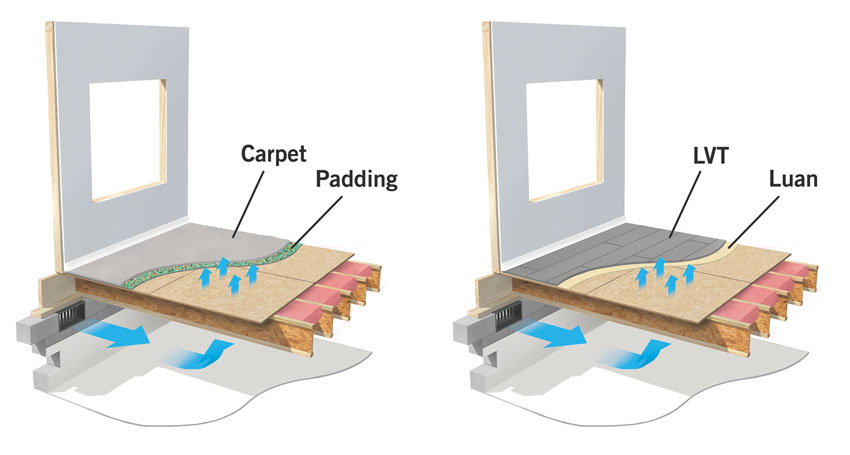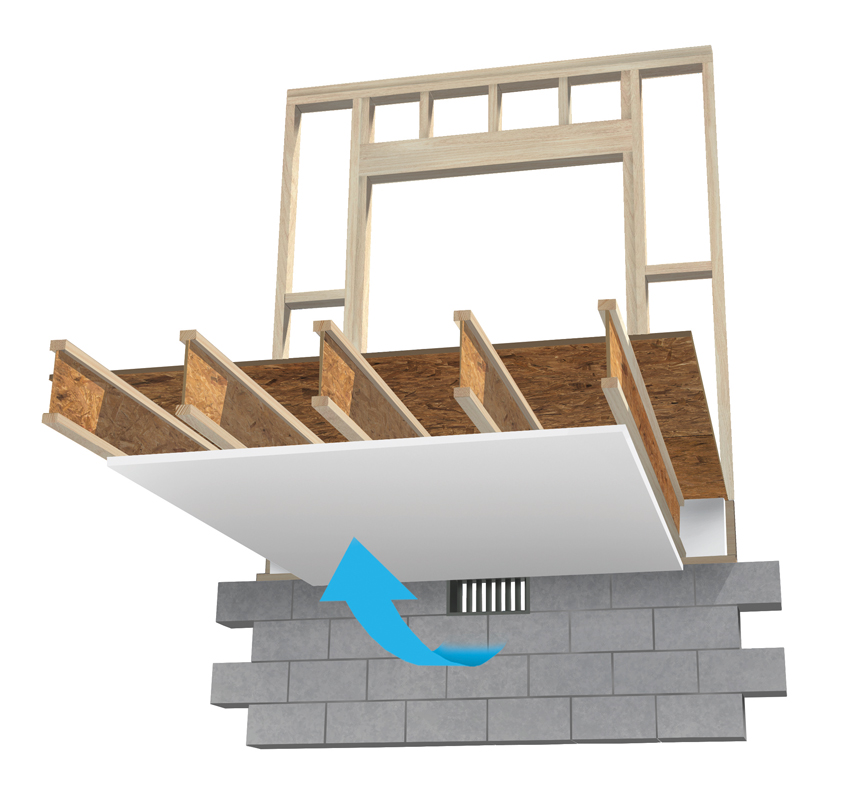The Building Science of Floor Systems
Consider Unvented Crawl Spaces
Based on their own testing, the people at BSC clearly state that they are not a fan of vented crawl spaces. They highly prefer the use of unvented crawl spaces that are constructed to the code-required level or better. In other words, make them mini-basements with all surfaces properly addressed. This means a continuous, overlapping, taped, and sealed Class I vapor retarder on the floor extending up the perimeter walls and any penetrations, such as piers or other items. Even better, a poured concrete floor with a vapor barrier below the concrete is preferred. The walls of the crawl spaces should be insulated and air sealed the same way other walls of the building enclosure are addressed. In this case, BSC points out that the structural walls in contact with the earth will be cooler than the typical summertime air temperature, such that any moisture that makes its way between the insulation and the walls may condense. Therefore, the insulation should allow for drying to the interior.
The floor assembly above unvented, sealed, and insulated crawl spaces should not be insulated, but rather it should be treated like other uninsulated framed floors above conditioned space. This is because BSC also recommends conditioning the air in the crawl space just like the indoor air above it is conditioned. Hence, the temperature and humidity of the crawl space are close to, if not the same as, the temperature and humidity of the space above it. As such, there is a balance or equilibrium so vapor movement becomes less prevalent and less of an issue. The crawl space is more accurately described as a conditioned crawl space rather than an unvented one. The recommendation is that airflows of 50 cubic feet per minute for each 1,000 square feet of crawl space be maintained.
In terms of flooring, conditioned crawl spaces allow the use of any type of flooring, including LVT and LVP, without many of the worries associated with vented crawl spaces. With fully conditioned spaces on both sides of the flooring, moisture or vapor should be able to dry readily on either side. Still, in this less-moisture-prone environment, a high-performance engineered wood subflooring product with ERS-1785 documented values is a better subflooring specification option. The additional performance benefits in this Evaluation Service Report include higher strength, stiffness, and fastener-holding design values than required for PS-2 panels. This type of underlayment adds the additional value of staying flat, smooth, and sturdy for long-term durability under finished flooring.
If Vented Crawl Spaces Are Used
If an unvented or conditioned crawl space is not feasible for any reason, the design of vented crawl spaces needs to be undertaken very carefully to create a design that is better than code minimum based on the following points.
- Material porosity: It is critical to be sure that moisture is addressed at all of the sources we discussed earlier. Begin by looking at all of the materials that are being used to surround the crawl space and understand their porosity and permeability. Waterproofing or at least damproofing of the walls will always be a good idea, just as it is in basement construction. Further, BSC recommends the use of “capillary breaks” (a non-permeable barrier) at key locations, such as between the footing and the crawl space wall, and at the top of this wall and the framing. This will help stop moisture from wicking up into the concrete or masonry and making its way where it is not wanted.

Images courtesy of Huber Engineered Woods, LLC
When looking at materials in a crawl space, it is important to allow for the permeance ability to increase, not decrease, as the assembly moves upward.
- Ground evaporation: Recognizing that a great deal of moisture can come from ground evaporation, it is wisest to simply plan on installing a continuous, sealed, Class I vapor retarder with the edges extended up at least 6 inches. The retarder is required anyway, so the incremental difference to seal the overlaps and extend it up is relatively small in the grand scheme of things. Note that 6-mil polyethylene, while minimally acceptable under the code, is not known for holding up very well when left uncovered. Therefore, a heavier material with some internal strength (e.g., some have fiberglass reinforcing) will be more effective and able to withstand people working on top of it, both during construction and the building life cycle.
- Surface drainage: Yes, the ground around the building should slope away from the crawl space. But other details like the entry or access door into the crawl space from the outside need to have a raised sill to keep water from running in. The code requires this in Section R408.4 of the IRC, stating, “The bottom of the areaway shall be below the threshold of the access opening,” although there is no prescriptive dimension for this. Further, BSC and others note that the presence of a roof overhang and gutters will help keep rainwater from falling and building up along the side of the crawl space by draining it away from the walls.
- Humidity: If a vented crawl space is being used, the air that enters in is going to be as humid as the air outside. Even though that may cause condensation on the cooler surfaces, such as the perimeter walls and the ground cover, those materials are not usually as prone to deterioration as wood and insulation. One effective means to protect the wood as recommended by BSC is to use foam insulation that covers the wood. This can be done in a few different ways.
- First, semi-permeable spray-foam insulation can be sprayed not only between the floor joists but also over and around them, thus fully encasing them in protective and insulating foam. This will work great as long as the drying toward the interior rule is still followed. That is easily accomplished with semi-permeable, high-performance subflooring and wood or carpet flooring. It is not necessarily accomplished by using LVT or LVP or other non-permeable flooring, so their use should be considered carefully in this case.

Image courtesy of Huber Engineered Woods, LLC
Closed-cell spray insulation can be used that does not cover the entire floor joist in locations where space below the floor is open to the air.
- Second, rigid, foil-faced foam boards can be installed continuously along the bottom of the floor joists and taped or otherwise sealed along the edges and joints. This creates a very non-permeable condition, even though it may be physically a bit more difficult to install in a shallow crawl space. The foil is an excellent vapor barrier as long as the tape or sealant is also equally excellent. Additional cavity insulation can be installed above the rigid boards (i.e., in between the floor joists) for additional insulating value. In this case, BSC recommends keeping a space between the top of the insulation and the subflooring. The rationale is that this will keep all of the wood the same temperature as the conditioned space above and therefore avoid condensation. In this non-permeable, fairly airtight, insulation-on-the-bottom scenario, any type of flooring can be considered fine to use. This includes LVT and LVP since they are now more permeable than the foil-faced insulation below and drying, if ever needed, can move to the interior.

Image courtesy of Huber Engineered Woods, LLC
Rigid polyiso insulation with a foil facing and taped edges/seams creates an impermeable condition that provides little opportunity for vapor intrusion, allowing virtually any type of flooring to be used.
- Third, if a flood-resistant condition is being designed with the building raised up on piers or stilts, it is likely that the sides are much more open on this type of under-floor space. The underside of the floor is quite well ventilated in this case, meaning that there is no cooling from the earth that can otherwise cause condensation in the summer. Here, insulation in the floor is still needed, perhaps more so to prevent an air-conditioned main floor from causing condensation on the underside of the floor. However, it likely does not need to fully encase the floor joists as described above. Instead, spray-foam or similar insulation can be installed between the joists as long as it also seals completely to the joists. Flooring guidelines as in the first option above apply here as well.
- First, semi-permeable spray-foam insulation can be sprayed not only between the floor joists but also over and around them, thus fully encasing them in protective and insulating foam. This will work great as long as the drying toward the interior rule is still followed. That is easily accomplished with semi-permeable, high-performance subflooring and wood or carpet flooring. It is not necessarily accomplished by using LVT or LVP or other non-permeable flooring, so their use should be considered carefully in this case.
- HVAC: The purpose of a heating/cooling system in a building is to change the temperature (and humidity) on the inside compared to the outside. When the means to do that include installing equipment, ductwork, or other components in the crawl space, their impact on the crawl space needs to be considered. If the walls of the crawl space are not insulated, the ductwork or piping needs to be insulated. This prevents condensation from forming and adding to the moisture in the crawl space. The same could be said for plumbing, both hot and cold lines, to conserve energy and prevent condensation respectively. Relatedly, the occupants or users of the building can play a role by keeping the indoor air-conditioning temperature at a reasonable level. Setting the thermostat at a very low level will cool the building materials, making them more susceptible to cause condensation in assemblies, including crawl space floor assemblies.
- Maintaining subfloor integrity: When the floor assembly is being constructed, the integrity of all the materials needs to be maintained. The subfloor is often left exposed during construction until the very end when the finish flooring is installed. If the building is not yet closed in and it rains, standing water may form on the subfloor. This is another reason to use high-performance subflooring since it can resist damage and swelling (notably along the panel edges) much better than lower grades due to its superior ability to resist absorbing moisture. However, some construction crews are prone to look for a quick solution to drain away water in this case, so they will drill small holes into the subfloor and allow the water to fall into the crawl space. This should never be allowed since it can cause considerable problems with both the crawl space and the subflooring. Rather, rainwater should be swept off the subfloor and out of a door opening onto the ground.
Following these recommendations and best practices can help avoid the problems associated with crawl spaces, particularly when non-permeable flooring is used.
Conclusion
The design of a crawl space foundations needs to be coordinated based on whether or not it is vented, the quality of materials used in the wood floor assembly, and the permeability of the finish flooring. This is true for all projects but particularly in more humid climates. Recommendations for vented crawl spaces are based on increasing the permeability from the bottom up, allowing for drying to occur toward the interior. This may mean avoiding the use of impermeable flooring, such as LVT or LVP. Wherever possible, however, properly designed and constructed unvented or conditioned crawl spaces are preferred since they eliminate many of the problems associated with vented crawl spaces and can allow the use of any type of flooring. In all cases, using high-performance materials for the subfloor can help with overall design strategies, guard against some potential problems, and contribute to a successful project for all involved.
Peter J. Arsenault, FAIA, NCARB, LEED AP, is a nationally known architect, consultant, continuing education presenter, and prolific author advancing building performance through better design. www.linkedin.com/in/pjaarch, www.pjaarch.com









